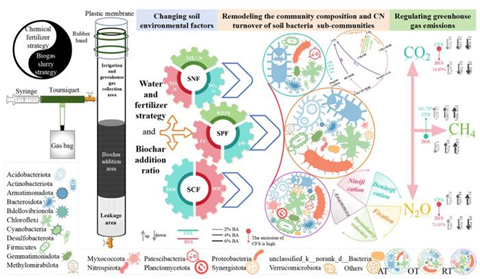Adding biochar to farmland soils is widely promoted as a climate-friendly practice, but its impact on greenhouse gas emissions can vary. A new study finds that pairing biochar with biogas slurry, a nutrient-rich liquid fertilizer from biogas production, can reshape soil microbial communities and significantly alter emissions of carbon dioxide (CO₂), nitrous oxide (N₂O), and methane (CH₄).

Researchers from the Chinese Academy of Agricultural Sciences conducted controlled soil column experiments to test how different levels of biochar addition perform under two fertilization strategies: traditional chemical fertilizers and the biogas slurry strategy (BSS). They measured greenhouse gas emissions and tracked shifts in soil bacterial “sub-communities”—groups of microbes that play distinct roles in soil carbon and nitrogen cycling.
READ MORE: Biochar and microbe synergy: a path to climate-smart farming
READ MORE: Biochar boosts black soil health and crop yields, study finds
The team found that under conventional chemical fertilizer use, biochar consistently reduced CO₂ emissions by nearly one-third. However, it also increased emissions of CH₄ and N₂O, two potent greenhouse gases. When the fertilization strategy was switched to biogas slurry, CO₂ emissions dropped by about 15% and N₂O emissions fell by more than 70%. CH₄ emissions, however, rose sharply, highlighting a tradeoff. Interestingly, the impact of biochar depended on its application rate: while 4% and 6% biochar additions amplified the emission reductions seen with biogas slurry, a lower 2% dose reversed the effect.
Fertilization strategy
“Our results show that the effectiveness of biochar in reducing greenhouse gas emissions depends strongly on the fertilization strategy used,” said corresponding author Dr. Jiandong Wang. “Biogas slurry not only changed the amount of gases released but also reshaped the microbial pathways that control those emissions.”

The study revealed that biogas slurry and biochar together enriched certain “rare” bacterial sub-communities, which proved surprisingly important in regulating emissions. These microbes altered how carbon and nitrogen were processed in soils, demonstrating what the researchers call a “priority effect”—where specific microbial groups take the lead in steering greenhouse gas outcomes.
Carbon sequestration
The findings suggest that simply adding biochar is not a one-size-fits-all climate solution. Instead, its benefits depend on aligning application rates with local water and fertilizer practices. By combining biochar with organic fertilizers like biogas slurry, farmers could enhance carbon sequestration while lowering harmful N₂O emissions, though methane management remains a challenge.
“This research provides new scientific evidence for designing integrated soil management strategies,” said co-author Dr. Xurong Mei. “With careful optimization, biochar and biogas slurry together could help agriculture contribute to climate change mitigation and sustainable food production.”
The article is published in Biochar.







No comments yet